| ART MOVEMENTS OF THE PAST 150 YEARS |
 |
Art through the ages has always been influenced by society, and in return society has found itself influenced by art. The paintings, drawings, and sculpture of artists past offer an often beautiful, sometimes haunting, but always human glimpse into the history we all share.
This brief synopsis of the art movements of the last 150 years looks at the origins of these movements, and the ways in which they influenced one another.
|
| REALISM: 1840s-1880s
|
 |
|
Considered by some to be the first truly Modern art movement, Realism grew up in a period of intense social and political change in Europe. Disillusioned by the images of perfection and idealism portrayed in Romanticism and other styles approved by the Academy (those who curated what was seen as "high" art), Realist artists began depicting everyday scenes with a similar detailed and realistic treatment, thereby raising chance meetings on the road and men breaking stones at the quarry to the importance of the previous historical and mythological scenes.
Realist artists still submitted works to the Salons held each year to showcase the best new art, but they also held their own exhibits for those works deemed unacceptable for public consumption.
INFLUENTIAL ARTISTS
- Gustave Courbet
- James Whistler
- Honoré Daumer
- Jean-Francois Millet
|
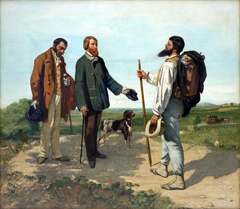
Bonjour, Monsieur Courbet - Courbet, 1854
|
| IMPRESSIONISM: 1865-1892
|
 |
|
Following Realism, and emerging as a further reaction against the enforced style of the Academy, which was widely considered to the only "true" style of art, Impressionism took the tenants of Realism one step further. Like their precursors, they chose to depict everyday life rather than lofty historical scenes. However, they showed the world around them in the form of fleeting "impressions" that carried a hint of abstraction and an air of immediacy. Impressionism also popularized the practice of painting en plein air, or out of doors.
There is some disagreement as to whether Realism or Impressionism was the first distinctly Modern art movement. And indeed, some artists whose early work was categorized as Realism later became part of the Impressionism movement.
INFLUENTIAL ARTISTS
|
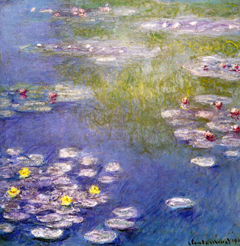
Nympheas at Giverny - Monet, 1908
|
| POST-IMPRESSIONISM: 1885-1915
|
 |
|
Post-Impressionism includes a range of artistic styles that surfaced once artists, critics and the public began to accept the legitimacy of art styles beyond realism. Neo-Impressionism, Symbolism, and Pointillism are a few of the forms that emerged.
Artists began to create highly personal artworks, and experiment with color, order, and paint application. Though it is easy to see how these qualities resulted in varied styles, most post-impressionists leaned towards abstraction in their pieces, continuing what the Impressionists had started and paving the way for the modernist styles of the next century.
INFLUENTIAL ARTISTS
|
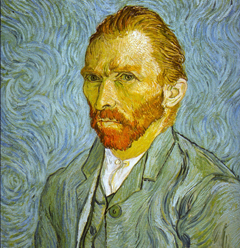
Self-Portrait - Van Gogh, 1889
|
| FAUVISM: 1900-1908
|
 |
|
Inspired by the work of the Post-Impressionists, Fauvism originated in France and was given their name by a critic of their work, much like the Impressionists. They were called "wild beasts" due to their enthusiastic use of color and disregard for realistic application of it.
Instead, the artists used colors that expressed the emotion they wanted to depict, either their own or the subject's. Fauvism highlighted the flatness of the canvas on which the art was created. This was done by simplifying form and oversaturating color.
Fauvism is considered a significant precursor to Cubism and Expressionism.
INFLUENTIAL ARTISTS
- Henri Matisse
- Georges Braque
- André Derain
- Raoul Dufy
|
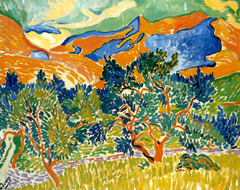
Mountains at Collioure - Derain, 1905
|
| EXPRESSIONISM: 1900-1935
|
 |
|
Spurred by the fear of loss of authenticity, Expressionism was partly a reaction against Impressionism and the academic art that movement had itself rebelled against. This new style sought distortion of form, and a use of strong color. Though it began in Germany, the movement spread through Europe and eventually influenced Abstract Expressionism in Europe and North America.
As the name suggests, Expressionist painting was expected to depict the feelings and conflicts within the artist, rather than reiterating what could be seen in the world around them. Exaggerated brushstrokes and swirling lines were meant to show the anxious emotional state of the modern artist.
INFLUENTIAL ARTISTS
|
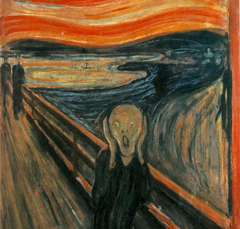
The Scream - Edvard Munch, 1893
|
| CUBISM: 1905-1920
|
 |
|
Considered another of the "truly modern" art movements, Cubism is credited to the work of Pablo Picasso and Georges Braque. The movement has two distinct stages: Analytical Cubism and Synthetic Cubism. Analytical Cubist paintings are fragmented in geometric shapes, while Synthetic Cubist works used newspaper and other generic items such as chair caning to collage a creation on canvas.
The primary facet of Cubism was the complete rejection of perspective, which had been utilized by artists in the Renaissance. Instead, fractured sections of the subjects were depicted in a flattened space with little depth of field.
INFLUENTIAL ARTISTS
- Pablo Picasso
- Georges Braque
- Juan Gris
- Raymond Duchamp-Villon
|
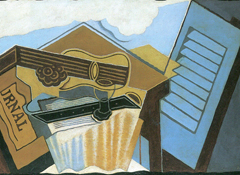
The Cloud - Juan Gris, 1921
|
| FUTURISM: 1909-late 1920s
|
 |
|
Considered one of the most significant 20th century art movements in Italy, Futurist art depicted the eagerness of artists to embrace the technology and general modernity of their time. Machines, the growing speed with which life moved, and the constant change were highlighted Post-Impressionism inspired painting and sculpture, though some artists used the new technologies to create their art.
Futurist art tried to depict all the facets of modern living, beyond those visible to the naked eye; this included the noise, rising temperatures, bustle, and scent of the growing urban centers. The artists dabbled in different styles until their form was largely unified in 1911.
INFLUENTIAL ARTISTS
- Umberto Boccioni
- Giacoma Balla
- Natalia Goncharova
- Carlo Carrà
|
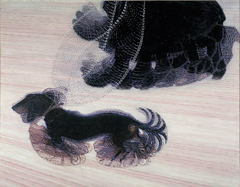
Dynamism of a Dog on a Leash - Balla, 1912
|
| DADA: 1916-1924
|
 |
|
Encompassing both visual and literary art, the Dada movement was a reaction against the nationalism and rationality the artists felt was brought on by the first World War. Those involved presented mocking and nonsense performance, poetry, painting, collage, and more. The now-famous readymades (such as Duchamp's "Fountain" urinal piece) were inspired and often considered part of the movement.
The movement officially formed after a Zurich cabaret in celebration of Voltaire's "Candide", which famously mocked society. They were also influenced by Futurism and Expressionism. When Surrealism began in the mid 1920s, the Dada movement largely faded.
INFLUENTIAL ARTISTS
- Marcel Duchamp
- Hugo Ball
- Hans Arp
- Man Ray
|

Fountain - Duchamp, 1917
|
| SURREALISM: 1924-1966
|
 |
|
Founded by a group of Parisian artists and writers, Surrealism focused on depicting the subconscious with the goal of unlocking the imagination. The movement was largely influenced by the work of psychiatrist Sigmund Freud and socialist Karl Marx. Their inspirations and beliefs were outlined in the 1924 "Le Manifeste du Surréalisme," written by André Breton.
The movement is seen by many as the most influential of the 20th century. In addition to fine artworks, many of the group had great commercial success in the areas of advertising, film, and photography.
INFLUENTIAL ARTISTS
- Salvador Dali
- Joan Miró
- Max Ernst
- Rene Magritte
|
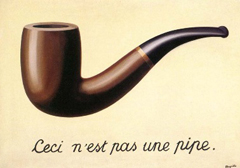
"Ceci n'est pas une pipe" (This is not a pipe) - Magritte, 1928
|
| ABSTRACT EXPRESSIONISM: 1940s-1950s
|
 |
|
Expressionism was practised by a group of artists - mostly American - who utilized extreme emotion in creating their artwork. Despite their similar inspirations, the movement encompassed a range of styles from the color field paintings of Mark Rothko to the harsh and abstracted nude portraits of Willem de Kooning.
Abstract expressionist artwork was celebrated as the first American avant-garde movement, and for accurately reflecting the American "spirit." Though largely made up of painters, the movement also consisted of some photographers and sculptors.
INFLUENTIAL ARTISTS
- Willem de Kooning
- Mark Rothko
- Jackson Pollock
- Franz Kline
|
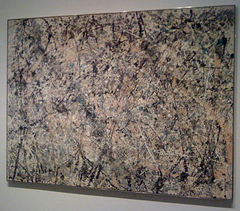
Lavender Mist - Pollock, 1950
|
| POP ART: 1960s
|
 |
|
Another essentially American art movement was the Pop Art phenomenon of the 1960s. On the heels of the Abstract Expressionism success, the movement brought figurative work back in a very literal way. Pop Art drew its inspiration and creative fodder from recognizable visual elements from popular culture, such as celebrity photographs and advertising images and slogans.
A goal of the Pop Art movement was to muddy the line between high art and what was seen as "low" culture. Its proponents believed there should be no hierarchy in art, and artists should be free - and encouraged - to find inspiration in whatever they chose. Appropriation of well known images was also celebrated, particularly with the works of Andy Warhol.
INFLUENTIAL ARTISTS
- Andy Warhol
- Roy Lichtenstein
- Jasper Johns
- Robert Rauschenberg
|

Campbell's Soup I - Warhol, 1968
|
| CONTEMPORARY ART MOVEMENTS
|
 |
|
It seems it is always simpler to identify a specific movement, be it artistic, social, or political, once it has already been and gone. Because many of the art movements of the late 20th century are still in practice, it is possible only to discuss the visible changes from past movements and speculate on influence and the future of these new styles.
Contemporary art movements and styles include hyperrealism, stuckism, graffiti, digital art, Maximalism, body art, and countless more.
POSTMODERNISM
This style is most commonly thought of in architecture, where it attempts to marry aesthetic and practicality. As such, it can take on many appearances. In recent years, there appears to be a shift from futuristic starkness and straight lines (vestiges of Modernism) to more organic structures, or the juxtaposition of old and new architectural aspects.
In other art, postmodernism is a term applied to much the "contemporary" art. It could be said that while all postmodern art is contemporary, not all contemporary art is postmodern.
Some of the sub-categories within postmodernism include Conceptual Art, Installation Art, and New Classicism.
HYPERREALISM
A painting and sculpture movement that returns to the Renaissance styles of painting realistic scenes, but takes it one step farther in the creation of Photorealistic art. Many hyperrealism paintings are indistinguishable from photographs, and they often serve as political, societal, or religious commentary.
Hyperrealist artists include Charles Bell, Duane Hanson, and Carole Feuerman.
STUCKISM
Founded in 1999 by two British artists, Stuckism to promote a return to figurative painting from the conceptual work that so permeated the art world at that time. Since then, the original 13 member movement has expanded to over 200 groups in more than 50 countries. They have also grown to work in the mediums of photography, sculpture, collage, and film, in addition to painting.
Stuckism artists include Billy Childish, Charles Thompson, Ella Guru, and Bill Lewis.
INFLUENTIAL CONTEMPORARY ARTISTS
- Frank Gehry
- Marina Abramovich
- Banksy
- Christo & Jeanne-Claude
- Chuck Close
- Anish Kapoor
- Jeff Koons
- Cindy Shermann
|

Contemporary architecture, architect unknown

Graffiti art, artist unknown
|
| ART MOVEMENTS IN OTHER COUNTRIES
|
 |
Art movements that originated in Europe and North America are by far the most talked about and best known movements in the "Western" world. This certainly does not mean, however, that other countries did not have art movements of their own while these more visible movements were front and center.
RUSSIAN ART
In the 20th century, Russian artists were involved in widespread movements such as Abstract Expressionism, Art Nouveau, Cubism, and Expressionism, but many also joined Russian-origin groups and movements prompted by Russian culture and experience.
BLUE ROSE GROUP
A Symbolist artistic association that existed from 1906 to 1908, the Blue Rose group sought to create rhythm in painting through fluid brushstrokes and non-figurative elements. The famous Russian artist Wassily Kandinsky, who is widely credited with the first truly abstract painting, contributed to the group's exhibits before branching off into Expressionism.
NEO-PRIMITIVISM
This Russian movement was inspired by a pamphlet of the same name, published in 1913 by Aleksandr Shevchenko. The publication encouraged a new art style that blended the of Cezanne, Cubism, and Futurism, as well as aspected of existing Russion folk art such as the lubok (a print with simple images and narratives outlining stories from religion and popular culture) and the Russian icon (small religious paintings on wood).
GUTAI GROUP, JAPAN
The first radical artistic movement in Japan, the Gutai Group was formed in 1954 around the reactionary art of the period. Abandoning traditional visual art media, the movement instead focused on the "immediacy" of performance art, using multimedia and theatrical performances to depict the pursuit of originality. The Gutai Manifesto was written in 1956.
The group was founded by Shozo Shimamoto and Jiro Yoshihara, and included artists Saburo Marakami, Takesada Matsutani and Atsuko Tanaka. Gutai Group was dissolved in 1972 following the death of Yoshihara.
THE BENGAL SCHOOL, INDIA
An avant-garde movement against the Western academic influences of composition and perspective that had begun to infiltrate Indian art, the Bengal School was developed at the turn of the 20th century, and encouraged by established artists Raja Ravi Varma and Abanindranath Tagore. The movement was taken up both by these and other Indian artists, and art schools in Britain.
|
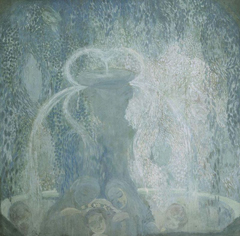
Blue Fountain - Kuznetsov, 1905 (Blue Rose Group)
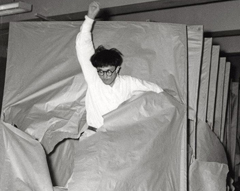
"At One Moment, Opening Six Holes" - Marakami, 1955 (Gutai Group)
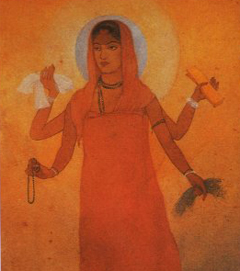
Detail of "Bharat Mata" - Tagore, around 1900 (Bengal School)
|
|
Has this article inspired you to get your hands on some of the artwork that inspired most of these movements? Visit our Classic Art page and choose from hundreds of paintings and drawings by some of the famous artists from the past 200 years.
Much of the research for this article was made possible by The Art Story website.
|
|
© 2002-2026 - KeenART Media Ltd.
|
|
| |
|
